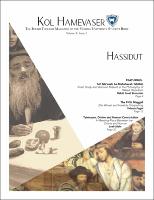Please use this identifier to cite or link to this item:
https://hdl.handle.net/20.500.12202/4415Full metadata record
| DC Field | Value | Language |
|---|---|---|
| dc.contributor.author | Yeshiva University Student Body | - |
| dc.date.accessioned | 2019-06-18T15:27:08Z | - |
| dc.date.available | 2019-06-18T15:27:08Z | - |
| dc.date.issued | 2017-01 | - |
| dc.identifier.citation | Kol Hamevaser : Hassidut. (January 2017). 10(2). | en_US |
| dc.identifier.uri | http://kolhamevaser.com/wp-content/uploads/2019/01/10.2%20Hassidut.pdf | en_US |
| dc.identifier.uri | https://hdl.handle.net/20.500.12202/4415 | - |
| dc.description | Student periodical with faculty contributions | en_US |
| dc.description.abstract | "It is the belief of the editors of Kol Hamevaser that the tools and resources of the academy can serve as both an enriching complement to traditional Torah learning and a gateway to enhanced depth of avodat Hashem (service of God). The goal of this issue of Kol Hamevaser is to explore the history and philosophy of Hassidism from a perspective that is at once academic and anchored in an underlying adherence to Halakhic Judaism. In this volume, the reader will find articles exploring the approaches of Hassidic masters to topics of parshanut (Torah commentary), aggada (homiletics), and mahshavah (Jewish philosophy): Leah Klahr discusses the esoteric notion of tzimtzum (Divine contraction); Yisrael Ben-Porat presents a Hassidic perspective on Hazal’s conception of Keri’at Yam Suf (the Splitting of the Reed Sea); Tzvi Benoff contemplates Rabbi Menachem Mendel Schneerson’s approach to Rashi’s use of Targum Onqelos in light of expanded historical evidence; and Judy Leserman probes the spiritual value of music from the standpoint of Habad Hassidut. Additionally, the reader will also find articles touching on the influence of Hassidic themes and teachings upon the contemporary broader Jewish milieu, as in Yehuda Fogel’s study of the late Elie Wiesel as a storyteller and Netanel Paley’s reflection on the current state of spirituality at Yeshiva University." | en_US |
| dc.language.iso | en_US | en_US |
| dc.publisher | Yeshiva University. | en_US |
| dc.relation.ispartofseries | Kol Hamevaser;10(2) | - |
| dc.rights | Attribution-NonCommercial-NoDerivs 3.0 United States | * |
| dc.rights.uri | http://creativecommons.org/licenses/by-nc-nd/3.0/us/ | * |
| dc.subject | Torah study and actional mitzvot | en_US |
| dc.subject | Habad Hassidism | en_US |
| dc.subject | Jewish philosophy | en_US |
| dc.subject | Elie Wiesel | en_US |
| dc.subject | Tzimtzum | en_US |
| dc.subject | Divine and human constriction | en_US |
| dc.subject | Leipzig manuscript (MS Leipzig 1) | en_US |
| dc.subject | Rabbi Menachem Mendel Schneerson | en_US |
| dc.subject | Rashi's use of Targum | en_US |
| dc.subject | Tanya | en_US |
| dc.subject | Education of children 'According to his way' | en_US |
| dc.subject | Making a Mikdash | en_US |
| dc.subject | Neo-Hassidism | en_US |
| dc.subject | Spirituality (Modern Orthodox) | en_US |
| dc.subject | Why did Yonah run? | en_US |
| dc.subject | Obligation and brotherhood | en_US |
| dc.title | Kol Hamevaser ; [January 2017] | en_US |
| dc.title.alternative | The Jewish Thought Magazine of the Yeshiva University Student Body | en_US |
| dc.type | Journal | en_US |
| Appears in Collections: | Kol Hamevaser | |
Files in This Item:
| File | Description | Size | Format | |
|---|---|---|---|---|
| Kol Hamevaser 10.2 Hassidut.pdf | PDF from website | 1.62 MB | Adobe PDF |  View/Open |
This item is licensed under a Creative Commons License

